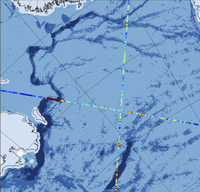
Sea Ice Thickness measurement using Satellite Altimetry
A new version is available:
It includes the ice freeboard, the snow depth and the sea ice thickness it covers up to 2019 and the Austral Sea Ice !
The data are monthly maps but we can also provide along-track data.
Click here to access the data using the request form
Motivations
The sea ice and its snow coverage has important effects on the global climate because of its albedo, which reject back the solar radiations and limit the water heating, and its isolation properties, which limits the exchanges between the water and the atmosphere. The melting and freezing processus also modify the thermohaline circulations, and the sea ice thickness and the snow depth impact the primary production.
The only technics to measure the sea ice thickness at ocean scale is based on satellite altimetry (see bellow). Some other satellite instruments allow to estimate thin sea ice thickness coupling sea ice growth model and observation of surface temperature and salinity (SMOS).
Measurements Principles
The principle is simple: it consists in measuring the height of the ice floes and the height of the water within the surrounding fractures of the ice (the leads and the polynya). The difference of the height of the floe and the height of the water provides with the height of the ice emerging above the water: the freeboard. Knowing the density of the ice and the water, the ice thickness can be estimated from the hydrologic equilibrium equation.
The application of this principle is not so easy for several reasons: 1) because of the mixing-up of ice and water within the radar footprint and the roughness of the surface of the floes, the altimetric measurements are often very noisy and difficult to analyse; 2) the ice is often cover by snow, which modifies the height measured over the floes according to the radar frequency, its penetration in snow and the slow down of its propagation speed; 3) the snow load has also the effect to dig the floe into the water, reducing the freeboard without reducing the thickness.
Because of these difficulties, the conversion of the freeboard observed by the altimeter (or “radar freeboard”) to the ice freeboard, and finally to the ice thickness introduces uncertainties that mainly depend on the altimeter performances, the uncertainties on the snow depth and on the snow and ice densities. These uncertainties are estimated and provided within our products. See the Sea Ice Thickness Product Handbook and [Guerreiro-2017] for more information.
Available Products
For now 3 products are available for the North Hemisphere (NH):
| Product | Satellite/Altimeter | Covered Region | Covered Period | DOI |
|---|---|---|---|---|
| SIT NH ENV | Envisat/RA2 | Arctic: 65°N < lat < 81.5°N | 2002-2012 | 10.6096/CTOH_SIT_NH_ENV_2017_01 |
| SIT NH C2 | CryoSat-2/SIRAL | Arctic: 65°N < lat < 88°N | 2010-2017 | 10.6096/CTOH_SIT_NH_CS2_2017_01 |
| SIT NH ENV C2 | Envisat + CryoSat-2 | Arctic: 65°N < lat < 81.5°N | 2002-2017 | 10.6096/CTOH_SIT_NH_ENV_CS2_2017_01 |
Description of the products:
Common characteristics of the products:
| Grid Format | EASE Grid of 722 x 722 pixels |
| Spatial Resolution | 12.5 km x 12.5 km |
| Time Sampling | monthly, from November to April |
| Main Parameters | radar freeboard, sea ice thickness, sea ice thickness uncertainties |
| Auxiliary Parameters | snow depth, snow density, sea ice density, MYI fraction, lon, lat, time |
| File Format | NetCDF CF-1.6 NETCDF4_CLASSIC |
References and Citations
- User handbook: Sea Ice Thickness User Handbook
- Reference publication: [Guerreiro-2017] Guerreiro, K., Fleury, S., Zakharova, E., Kouraev, A., Rémy, F., & Maisongrande, P. (2017). Comparison of CryoSat-2 and ENVISAT radar freeboard over Arctic sea ice: toward an improved Envisat freeboard retrieval. The Cryosphere, 11(5), 2059. https://doi.org/10.5194/tc-11-2059-2017.
Usage Conditions
Free access with condition of citing the product source (DOI of the selected product and [Guerreiro-2017])
